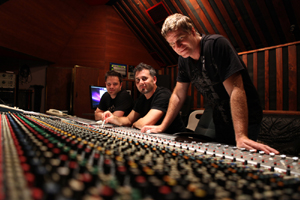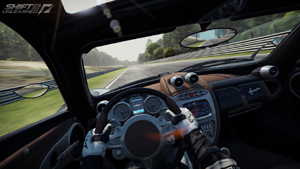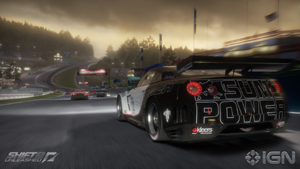Game Scoring: “Need for Speed: Shift 2 Unleashed” – Remixing Anberlin, Rise Against and More
FASHION DISTRICT, MANHATTAN: Strapping yourself in to play the heart-stopping EA race game, Need for Speed: Shift 2 Unleashed, you realize that reality rules. From the helmet-cam to the tire pressure and every bump on the racecourse, everything here is as real as it gets. Except for the music – which is as unreal as they could make it.
Available on the Xbox 360, Playstation 3 and PC since the end of March, Unleashed intentionally messes with the standard notion of licensing tracks for video games. First, EA’s famed, Vancouver-based Black Box Studios got the rights to 10 killer rock songs: “Night Of The Hunter” by 30 Seconds To Mars, “We Owe This to Ourselves” by Anberlin, “Mountains” by Biffy Clyro, “Ours” by The Bravery, “Issues” by Escape the Fate, “Levitate” by Hollywood Undead, “Action Needs An Audience” by Jimmy Eat World, “Help Is On The Way” by Rise Against, “Take A Load Off” by Stone Temple Pilots, and “The Sound (John M. Perkins Blues)” by Switchfoot.
Next step: get seven top game composers on the case to create a multi-genre slew of remixes, making “heroic”, “surreal” and “dirty” versions of each song to play out at various stages of gameplay.
GETTING IN ON THE PROJECT
Here in NYC, it was the composer/producers at Heavy Melody that emerged as the top choice to give the songs the “dirty” flavor (read twistedly gritty electronica), joining them with what would be one of the largest composition teams Black Box had ever hired to score a game. Ramin Djawadi, Troels Folmann, and Mick Gordon were selected for Heroic (Epic, Hybrid Orchestral), and Stephen Baysted joined Djawadi for the Surreal set (Ethereal Orchestral, dreamy).
The Heavy Melody squad – Dave Fraser, Neil Goldberg, and Ari Winters – was first paired with Black Box Audio Director Charles Deenen to score Need for Speed: Hot Pursuit for Wii. Their software development alter ego, Heavyocity, had made a big impression on Deenen when he heard the Evolve and Mutations virtual instruments in action — it wasn’t long before he wanted the men behind the machines to be in on his game scores.
“A couple of months after Hot Pursuit wrapped, Charles called us and said, “We have this new concept for Need for Speed,” Fraser says. “Licensing songs for video games is not new, of course, but in this case they wanted to use the songs in a new way, remixing them into three emotional states: epic/heroic/gladiatorial, surreal/ethereal, and aggressive/electronic/industrial/dirty.
“Our job in doing the dirty remixes was to take the original songs and then reflect the angst and excitement of the driver before the race – give them this aggressive, racy kind of vibe.”

(l-r) Heavy Melody's Ari Winters, Neil Goldberg and Dave Fraser were the "dirty" choice for EA's Black Box Studios.
CREATING THE ELEMENTS
While typical video game scoring famously makes demands on composers to deliver a wealth of flexible stems and elements, Goldberg explains that Shift 2: Unleashed had less-daunting-than-usual deliverable requirements. “With games, there’s usually a long list of what’s needed to make it interactive. That wasn’t the story here – in this case, the music primarily had to be hard-hitting, and aggressive.”
Although the approval process would prove arduous, the reduced advance planning necessary gave Heavy Melody time and energy to do a lot less math and have a lot more fun. “We could focus on making beautiful tracks,” says Winters. “We didn’t have to say, ‘Will just one or two stems work by themselves?’ It was about making the track sound cool as a singular entity. The litmus test was if it would work on radio.”
Working in their spaciously stylish Fashion District studios, where they’ve worked on projects for clients such as 2k Games, Atari, The NFL, Sony, NBC and more, Heavy Melody started with each song’s vocal stems and then took a big detour from there.
“We took the lead and background vocals, and then recreated virtually everything else underneath,” Fraser says. “We took the tracks to places they hadn’t been before. We roto-rooted the sound of these tracks, and twisted them with a lot of weird experimentation. There were completely new bridge sections that we created, we would stretch the vocals, and really go extreme with it. It was pretty exciting.”
SOUND SCULPTING TOOLS
With tools like Digital Performer 7.22, the Dangerous D-Box, Native Instruments Kontakt 4, Evolve, Evolve Mutations, UAD-2 cards from Universal Audio, Waves Platinum, Soundtoys Decapitator, Ohm force, PSP Audioware, and the Brainworx Digital V2, Heavy Melody radically restructured the songs.
Listening to the stuttering mind-burst of remixes like STP’s “Take a Load Off” or the crushing pulsations of Anberlin’s “We Owe This to Ourselves” (several of the remixes are streaming from the Heavy Melody Website). You’ll hear the composer team was in their element as they attacked the remixes.
“Throughout the process, we focused not so much on the song structure, as the sound of the remixes,” Winters notes. “For example, we’d take three different versions of a snare – weird, punchy, echoed – combine them, and then continue to tweak. It was about making new sounds, sound by sound.”
LONG DISTANCE LISTENING
With audio director Deenen and the Black Box studios on another coast in another country, developing a common sonic language over long distance was essential.
“We had sonic tracks to reference and match in terms of frequencies,” Goldberg says, “and we spent a lot of time early on making sure we knew what was good sonically for him, so we could figure out how to duplicate that in our studio. Charles was very particular about the style and what he wanted it to sound like – very current.
“The sonic delivery of the remixes was equally as important as how cool the parts were. Charles is a recording engineer with a lot of years in the music industry, and an incredibly talented sound designer who’s mixed trailers for Hollywood films. He has an amazing 5.1 studio in Vancouver, and he really gets it.
“It was refreshing to talk to someone who says, ‘Can we increase the frequency range of this sound?’ Rather than the typical producer who says, ‘Can we just make it bigger?’ For example, he’d be listening there, and we’d be listening here in NYC on Genelecs and subs. He’d say, ‘Turn your sub off, and give me the biggest wall of low end you can pump out.’”
SURVIVING THE APPROVAL PROCESS
With not just notoriously exacting video game creatives to please, but also the rock stars that they had just remixed, Heavy Melody held their breath for the approval process.
“The final stage was the band, the label and the management signing off on the work that we did. After we spent two months honing these tracks we said, ‘What if the band hates these?’” says Winters. “We were really psyched when the emails came back, ‘Anberlin, approved. Rise Against, approved…’ Only STP requested slight changes to their track.”
NEXT THEY GET TO PLAY IT
With the game on the market and garnering great reviews, Heavy Melody has been glad to make it to the true final stage: The part where they grab their controllers, and play Shift 2: Unleashed with their music crunching hypnotically out of the speakers.
“You work so hard on a project, and when you’re at the end of it you get to the point where you’re burning out,” Goldberg says. “Not because it’s a bad project, but because it’s really hard work. You’re going back and doing the same thing over and over again to get it right. When it’s done and it’s the can, you get to take a breath.
“When it’s finally on the shelves and you can actually play, all you can say is, ‘Wow, this is the fruits of our hard labor.’ You get filled with goosebumps hearing it in the game itself.”
— David Weiss








